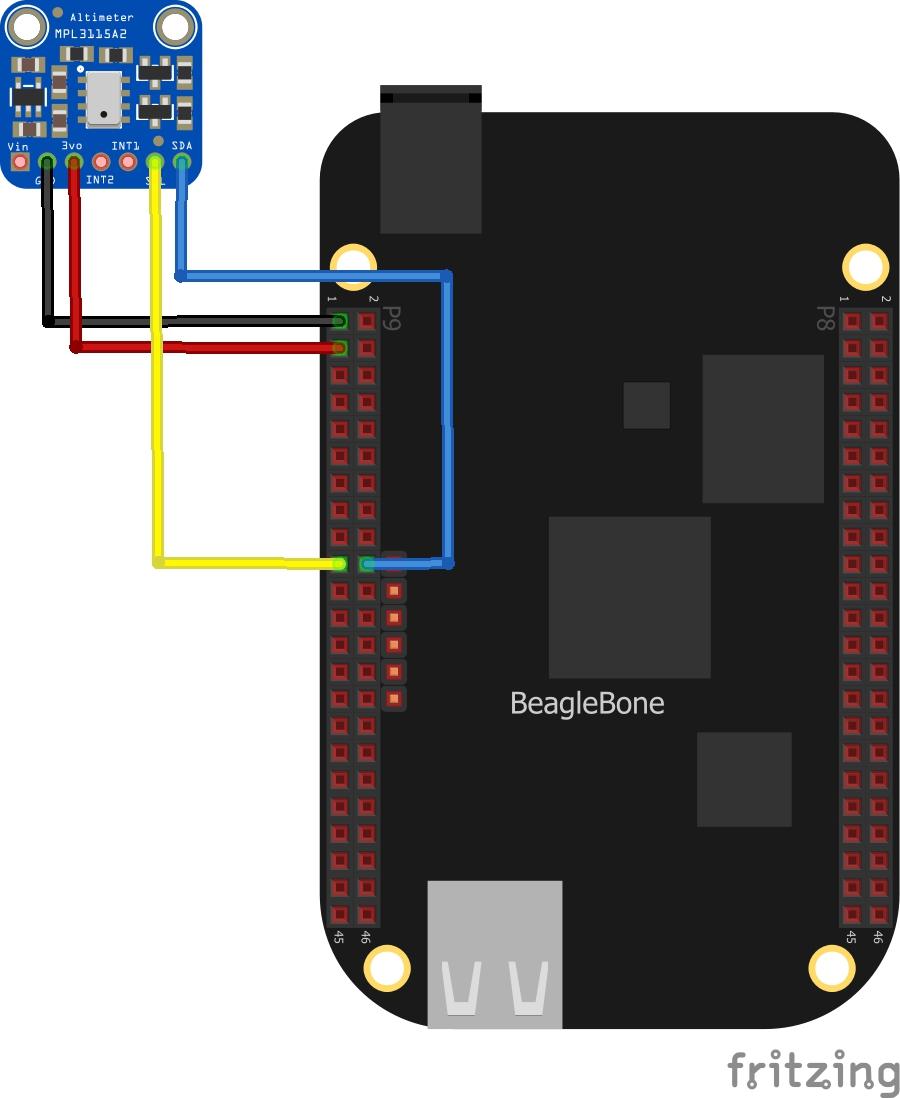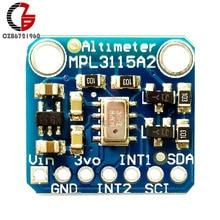In this article we look at an MPL3115A2 connected to a Beaglebone first of all lets look at the sensor.
The MPL3115A2 is a compact, piezoresistive, absolute pressure sensor with an I2C digital interface. MPL3115A2 has a wide operating range of 20 kPa to 110 kPa, a range that covers all surface elevations on earth. The MEMS is temperature compensated utilizing an on-chip temperature sensor. The pressure and temperature data is fed into a high resolution ADC to provide fully compensated and digitized outputs for pressure in Pascals and temperature in °C.
This typically comes in a breakout such as the one in the breakout below
Parts Required
Schematic/Connection

Code Example
This is a controleverything example. This is the C example from https://github.com/ControlEverythingCommunity/MPL3115A2
[codesyntax lang=”cpp”]
#include <stdio.h>
#include <stdlib.h>
#include <linux/i2c-dev.h>
#include <sys/ioctl.h>
#include <fcntl.h>
void main()
{
// Create I2C bus
int file;
char *bus = "/dev/i2c-2";
if((file = open(bus, O_RDWR)) < 0)
{
printf("Failed to open the bus. \n");
exit(1);
}
// Get I2C device, MPL3115A2 I2C address is 0x60(96)
ioctl(file, I2C_SLAVE, 0x60);
// Select control register(0x26)
// Active mode, OSR = 128, altimeter mode(0xB9)
char config[2] = {0};
config[0] = 0x26;
config[1] = 0xB9;
write(file, config, 2);
// Select data configuration register(0x13)
// Data ready event enabled for altitude, pressure, temperature(0x07)
config[0] = 0x13;
config[1] = 0x07;
write(file, config, 2);
// Select control register(0x26)
// Active mode, OSR = 128, altimeter mode(0xB9)
config[0] = 0x26;
config[1] = 0xB9;
write(file, config, 2);
sleep(1);
// Read 6 bytes of data from address 0x00(00)
// status, tHeight msb1, tHeight msb, tHeight lsb, temp msb, temp lsb
char reg[1] = {0x00};
write(file, reg, 1);
char data[6] = {0};
if(read(file, data, 6) != 6)
{
printf("Error : Input/Output error \n");
exit(1);
}
// Convert the data
int tHeight = ((data[1] * 65536) + (data[2] * 256 + (data[3] & 0xF0)) / 16);
int temp = ((data[4] * 256) + (data[5] & 0xF0)) / 16;
float altitude = tHeight / 16.0;
float cTemp = (temp / 16.0);
float fTemp = cTemp * 1.8 + 32;
// Select control register(0x26)
// Active mode, OSR = 128, barometer mode(0x39)
config[0] = 0x26;
config[1] = 0x39;
write(file, config, 2);
sleep(1);
// Read 4 bytes of data from register(0x00)
// status, pres msb1, pres msb, pres lsb
reg[0] = 0x00;
write(file, reg, 1);
read(file, data, 4);
// Convert the data to 20-bits
int pres = ((data[1] * 65536) + (data[2] * 256 + (data[3] & 0xF0))) / 16;
float pressure = (pres / 4.0) / 1000.0;
// Output data to screen
printf("Pressure : %.2f kPa \n", pressure);
printf("Altitude : %.2f m \n", altitude);
printf("Temperature in Celsius : %.2f C \n", cTemp);
printf("Temperature in Fahrenheit : %.2f F \n", fTemp);
exit(0);
}
[/codesyntax]
Save this as MPL3115A2.c, I used the Cloud 9 IDE
First of all compile the c program.
$>gcc MPL3115A2.c -o MPL3115A2
Run the c program.
$>./MPL3115A2
Output
After running you should see something like this
Pressure : 99.06 kPa
Altitude : 190.69 m
Temperature in Celsius : 21.56 C
Temperature in Fahrenheit : 70.81 F

